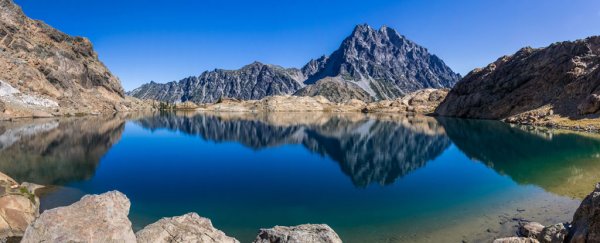It's not every day scientists say a new kind of renewable energy could satisfy the majority of our power needs, so when they do, it's worth leaning in close.
In a first-of-its-kind study, researchers have found that energy harvested from the evaporation of water in US lakes and reservoirs could power nearly 70 percent of the nation's electricity demands, generating a whopping 325 gigawatts of electricity.
Alongside the great strides being made in solar and wind, biophysicist Ozgur Sahin from Columbia University says natural evaporation represents a massive unexplored resource of environmentally clean power generation, just waiting to be tapped.
"We have the technology to harness energy from wind, water and the sun, but evaporation is just as powerful," Sahin explains.
"We can now put a number on its potential."
 Columbia University
Columbia University
Back in 2015, Sahin's team made headlines when they engineered a system to harvest electricity from evaporating water, thanks to – of all things – bacterial spores.
Sticking Bacillus subtilis spores onto thin strips of tape much like cassette tape, the researchers made an 'evaporation engine' to leverage the organisms' natural response to changes in humidity: shrinkage.
Or, more accurately, shrinkage and expansion. In various kinds of experiments using different kinds of prototypes, the researchers devised systems to expose the spores to more or less water.
When things get dry due to evaporation, the spores curl, which causes the tape to contract – but as the tape shortens, a small rig closes tiny window shutters, increasing the humidity in the bacterial chamber, meaning the cycle can repeat.
"They work like a muscle," Sahin explained to New Scientist at the time. "They can push and pull with a lot of force."
Attaching the engine to pistons enabled a small car to be powered, and could light up an electric LED.
Now, the same researchers have run calculations on what could be achieved if you scaled up the same kind of system over lakes and reservoirs throughout the US.
It would be quite a feat – not to mention a controversial eyesore – but if you were able to install floating spore-fuelled power generators using the principles of the evaporation engine over lakes and reservoirs larger than 0.1 square kilometres (0.04 square miles) in size, Sahin says you could generate 325 gigawatts of electricity-generating capacity.
"Evaporation comes with a natural battery," says one of the team, Ahmet-Hamdi Cavusoglu.
"You can make it your main source of power and draw on solar and wind when they're available."
But that's not all.
The researchers estimate the same system could actually save some 95 trillion litres (about 25 trillion gallons) of water lost to evaporation every year – approximately a fifth of what Americans consume annually.
Of course, building this kind of infrastructure would mean an end to sailing, fishing, swimming and all other kinds of activities on the water – plus there'd be cost considerations, and all kinds of questions over the environmental effects that might result.
In short, there's a huge amount of impracticality in this hypothetical vision, as promising as it is.
But the sheer amount of energy such a system could harness means we should be seriously thinking about what evaporation could do for us, Sahin says – by investigating the possibilities on a smaller, limited scale, before discounting it out of hand due to environmental concerns.
"These are very important issues, but we don't know enough about the technology to make these judgements," Sahin told Gizmodo.
"The present study is only one piece of the puzzle."
The findings are reported in Nature Communications.
